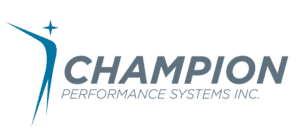As a business owner, you spend a lot of energy finding and retaining good employees. A bad hire can cost precious time and money and has the potential to disrupt otherwise healthy teams. Losing a great employee can affect business continuity, team morale, and the ability to continue scaling.
You want to hire people who fit your company culture and possess the “untrainable” traits you value in all employees. Beyond that, you also want high-performing employees who contribute to a productive workplace and are a good investment.
Great job if you’re already hiring and promoting employees based on your core values. That’s the first step toward building high-performing, productive teams. But simply hiring for cultural “fit” isn’t enough. Preparing employees to be high-performing contributors requires more than a vague idea or job description.
To thrive, employees need a clear vision and strategy, consistent goals and metrics, and confidence in their unique role in the company’s success. Even capable, qualified employees may not reach their full performance potential if they don’t have the right tools or information.
Building this framework for your business can be more complex than expected. That’s where a business coach can provide invaluable guidance on improving employee performance and setting the stage for a productive workplace.
What Is a Business Coach?
A business coach helps businesses develop and implement strategies that allow a company to scale or sustain growth. They provide objective observations, expert advice, accountability, and guidance to help companies succeed.
Business coaching can include goal setting, strategy creation, process development, and prioritization. An effective coach can also provide insight and actionable recommendations that help improve employee performance and boost workplace productivity.
How Is a Business Coach Different From an Executive Coach?
Though often used interchangeably, a business coach is not the same as an executive coach.
Business coaches work with an entire organization to scale or streamline a business. Executive coaches work one-on-one with leaders to identify and obtain individual goals. Though these goals may align with and complement overall business efforts to improve employee performance, executive coaching is based on the individual and can include personal development goals.
Does My Team Need a Business Coach?
It may be time to invest in a business coach if:
- Your employees don’t seem to understand your vision
- Your strategies aren’t working as expected
- Your employees aren’t meeting their goals
- You have trouble retaining good employees
- You’re not sure if your expectations are realistic
- Your leadership is going in different directions
- Your team feels lost or unsure of what is expected of them
Business coaches can help improve employee performance and overall workplace productivity. They provide the guidance and accountability needed to improve how you evaluate employee performance measurements. Here are seven ways business coaches help improve workplace productivity. But first, let’s talk about the major mistakes most businesses make when evaluating employee performance and productivity.
Common Mistakes in Employee Performance Evaluations
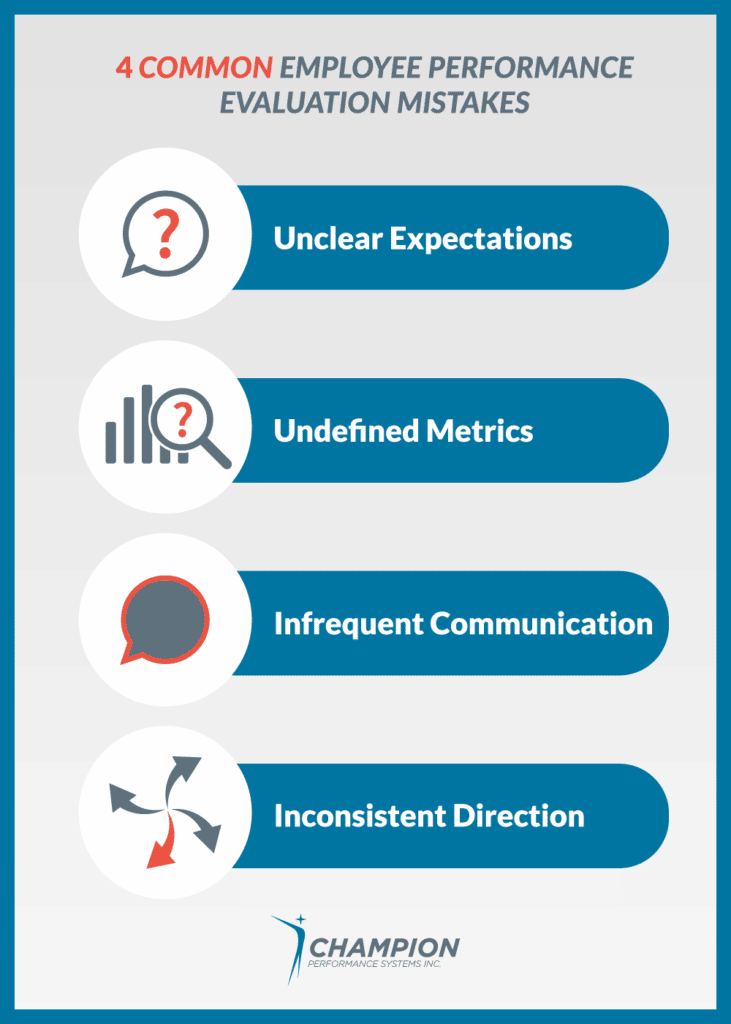
When evaluating employee performance, businesses often make the mistake of placing all responsibility for success on the employee: If an employee fails to meet performance expectations, they’re either not working hard enough or are incapable of doing their job.
However, this is only sometimes the case. In many instances, low employee performance directly results from murky expectations and metrics. Infrequent communication and inconsistent direction can also impact employees’ ability to effectively meet the performance expectations of leaders.
Unclear Expectations
Let’s say you hire a landscaping company to maintain your yard at home. In your vision, you expect the landscaper to mow the grass, weed the flower beds, and plant seasonal foliage. Instead, the landscaper trims the trees and waters existing plants. You would probably feel like the landscaper failed to meet your expectations. The landscaper, in turn, is confused about your dissatisfaction with their work.
In this scenario, both parties should have asked and answered vital questions about expectations. The landscaper may have done an excellent job — just not the job you expected.
Mismatched expectations in the workplace can lead to supervisors viewing employee performance as “poor.” In turn, the employee may feel dissatisfied and blindsided by unknown employee performance expectations.
Undefined Metrics
For employees to perform, they need to know how they will be evaluated. Too often, businesses set vague or subjective goals and fail to consider the benchmarks and metrics they will use to evaluate success.
Let’s say an HR team aims to fill all openings within 30 days. The team succeeds, but only half of the hires make it past their 90-day probationary period. This attrition could easily be seen as a failure on the HR team’s part. However, without the guidance of other metrics, the employees may feel they achieved the stated goal.
Additional benchmarks for filling all openings within 30 days may have significantly changed the team’s strategy for recruiting. Metrics for this goal may have also led the team to alert leadership that the plan was not achievable during that time frame. In any case, objective performance metrics for a goal ensure everyone is on the same page.
Infrequent Communication
Companies often rely on annual performance reviews to monitor and assess employee performance. Though annual reviews are crucial in measuring productivity, performance should be an ongoing conversation between employees and supervisors.
An employee should always know where they stand regarding performance. They should also feel confident they will receive constructive coaching and the tools they need to improve when things aren’t going well.
Many employee performance issues could be resolved with early intervention and regular communication about performance. However, the challenges of discussing performance can lead supervisors to avoid these conversations, hoping issues will resolve on their own.
Inconsistent Direction
When businesses hit a rough patch or undergo significant changes, it’s natural to enter “action” mode. Leaders and teams can be caught between proactively working toward established goals and reactively trying to solve the problem at hand. While it’s sometimes necessary to change course, this reactive strategy can leave employees unsure about priorities.
Unfortunately, frequent changes in priorities can leave employees feeling like they aren’t making progress. In turn, supervisors may view them as less productive. It’s important to consider outside influences on an employee’s bandwidth to accomplish outlined goals and their overall employee performance.
How Business Coaching Can Improve Employee Performance
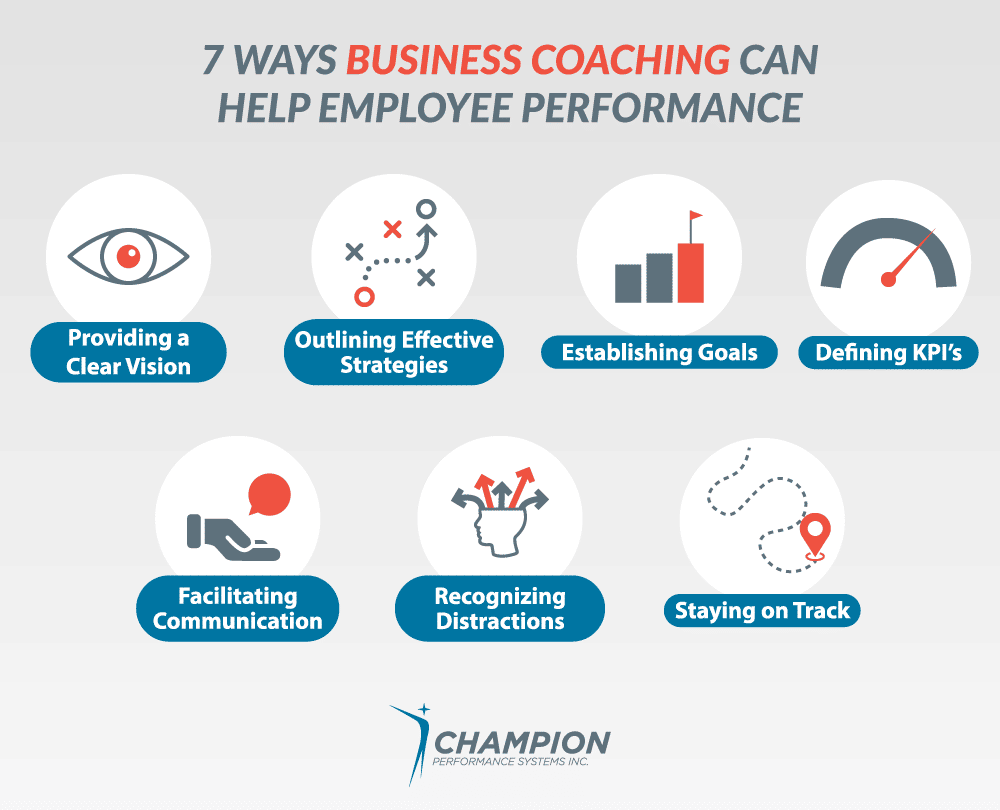

High-potential employees will almost certainly ask questions about goals and performance. They will instinctively want to know where the business is going and how they fit into the big picture.
However, questions about vision, strategy, and the company ecosystem go far beyond individual employee performance measures. These questions can impact every decision in your business, including how you hire, who you choose to work with, how you engage with your customers, and more. As a leader, it is your responsibility to ensure employees have a clear, documented path to success and understand the core of the business.
This can feel daunting, especially when you are busy running your business and unsure where to start. A business coach will help you define the vital framework needed for a thriving, productive workplace.
1. Providing a Clear Vision
Most people wouldn’t agree to board a plane with no final destination. How long is the flight? Where will we land? Did I pack the right clothes? Asking employees to fully invest in your business without giving them a clear vision is like asking them to board a plane without a destination. You probably won’t get many takers.
A clear vision statement that employees understand and can articulate is the first step toward gaining genuine buy-in. A shared vision that answers the question “where are we going?” is the foundation of high-performing teams and exceptional employee performance.
A business coach can help you outline your vision of success for your business. An effective business coach asks questions about your core values, core competencies, and the big-picture idea of success for your business. They work with leaders and team members across the organization to distill these values, dreams, and capabilities into a documented vision for the company. A business coach can help your team accomplish seven crucial steps to improve employee performance:
- Outline effective strategies
- Establish goals
- Define KPIs (key performance indicators)
- Facilitate communication
- Recognize distractions
- Stay on track
2. Outlining Effective Strategies
It’s not enough to know where you are going. You also need a plan for how to get there. Most companies have some strategic plans, but many fail to communicate them to their employees.
Short-term and long-term strategies serve as essential guides for team leaders and employees. Whether it’s an annual strategic plan or a specific strategy for a new launch or initiative, written strategies help answer the “how will we get there?” question for stakeholders in your organization.
Business coaches provide invaluable support in strategy development. They observe your teams to identify strengths and weaknesses you may be missing and translate those observations into actionable, timely strategies for improving employee performance.
3. Establishing Goals
Once an employee shares the company vision and understands the outlined strategy, a new question arises: Where do I fit in?
An employee’s job description provides an outline of their general tasks and job functions but little else. Employees need to know how they fit into the larger vision and the goals they will help achieve.
Team-specific and individual goals provide context for an employee’s daily tasks. Articulated goals help employees prioritize and ensure they dedicate their time to work that serves a specific goal and purpose. Goals must be SMART:
- Specific: The goal is clearly stated and can’t be misinterpreted.
- Measurable: The goal has objective measures you can use to evaluate progress.
- Achievable: The goal is reasonably achievable with the available resources.
- Relevant: The goal is relevant to the larger business goals and vision.
- Timely: The goal has a target completion date that can be tracked.
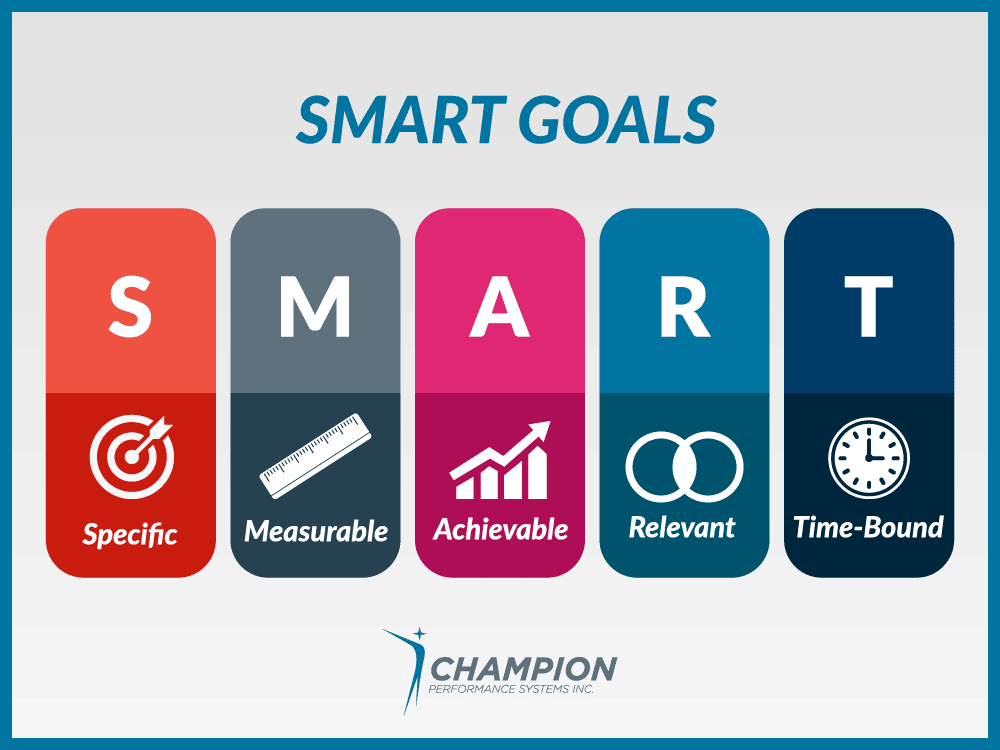
Business coaches are skilled at providing new, outside perspectives when setting SMART goals and can guide your team toward ambitious but achievable goals, resulting in greater productivity and employee performance.
4. Defining KPIs
Without defined metrics, perceived results are subjective. Employees may feel they have met a goal, while their leaders view the overall performance as poor. This lack of shared benchmarks for success impacts overall productivity and progress toward goals.
Knowing which KPIs to monitor can be tricky. Not all KPIs are relevant to every industry, job function, or goal. Some common KPIs include cash flow, customer retention rates, employee turnover, website traffic, and sales leads. Your KPIs are unique to your business and may change over time as your business grows or changes.
Many businesses make the mistake of not revisiting their KPIs to evaluate if they are tracking the right information. If a KPI doesn’t add clear value to big-picture decisions or help you improve your services or operations, it may be irrelevant. Tracking data like this can waste time and mental energy and detract from more important metrics crucial to the business.
Employees should have a say in the KPIs they will be responsible for, as they will have specific insight into past trends, market shifts, and what is achievable with their current resources. Business coaches also help ensure everyone is involved in setting KPIs. This increases buy-in, and collaboration with KPI stakeholders can help you develop relevant, achievable success metrics to optimize employee performance.
A business coach can provide a top-level, third-party perspective on setting KPIs and help you avoid falling for some of the most common KPI problems, like setting unrealistic goals or tracking irrelevant data.
5. Facilitating Communication
The best strategies, goals, and metrics are meaningless if no one knows about them. Clear, consistent, and frequent communication is key to successfully implementing change in your business. Overcommunciation is essential, especially when talking about vision and goals.
Effective teams consistently communicate their progress and whether or not they are on track to meet their goals. This can be through regular one-on-one meetings between employees and supervisors, all-hands meetings, and quarterly progress reports. Frequent communication about goals and progress provides transparency for employees and helps hold teams accountable for their metrics and overall employee performance.
Business coaches can help build a plan for how, when, and where progress will be communicated. As skilled communicators, they provide expert guidance on delivering messages effectively and constructively.
6. Recognizing Distractions
Workplace distractions can quickly derail progress and impact overall employee performance. Distractions can range from excessive emails and pointless meetings to incessant message alerts and disruptive environments.
In many ways, distractions are some of the simplest things to change. However, these changes can be challenging. Restructuring your work environment, setting meeting boundaries, and streamlining communications can take time to maintain. It requires intentional practice and a commitment to limiting distractions in the workplace.
You’ll need to identify opportunities to limit distractions by implementing standard structures for meetings and identifying unnecessary communication channels. Partnering with a business coach can make this easier.
7. Staying on Track
The most challenging part of fostering an environment of productivity is consistency. This requires radical change within your business and a company-wide commitment to processes, messaging, and metrics.
A business coach is an ongoing source of accountability for your business. And if you are regularly checking in with your coach, they may be able to spot potential challenges or issues before they arise.
Most importantly, they can provide the encouragement needed to keep pushing forward even if you feel overwhelmed or aren’t seeing the immediate progress you would like. Creating a business environment that values shared visions and goals takes time. A business coach can keep you on the right path while you do the work it takes to achieve your business goals, including employee performance targets.
Partner With a Business Coach To Improve Employee Performance

Creating an environment that fosters growth and productivity can take time and effort. Traditional go-to solutions like time and priority management can build a launchpad for high-performing employees. However, those solutions won’t have the maximum impact if key employee questions about their purpose go unanswered.
Setting an intentional vision for your business brings clarity and transparency to the workplace. When employees know where the company is going and their role in that vision, they can achieve those goals productively.
If you’re ready to empower your employees to be high-performing contributors but need help figuring out where to start, a business coach can lead the way. The coaches at Champion PSI have the real-world experience and expert knowledge required to help guide your business toward greater productivity and high employee performance. Learn more about how Champion PSI revolutionizes businesses with practical, world-class business coaching and take the first step toward improving your business’s productivity.
